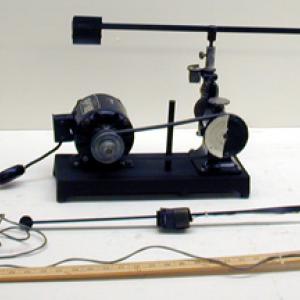College of Liberal Arts & Sciences
3B40.25 - Doppler Effect - Rotator App.
Make sure the rotators are in good shape. Tighten the desired arm securely and rotate at the desired speed.
CAUTION: Stay out of the way of the rotating arm when adjusting the speed.
Plug the generator into the auxiliary input of the amplifier. Plug the speaker that is on the yardstick into the speaker outputs of the amplifier. Swing the speaker back and forth and listen to the Doppler shift.
- Walter Schier, "Doppler Frequency Shift of Sound Apparatus", TPT, Vol. 49, # 4, p. 246, April 2011.
- Marcelo M. F. Saba and Rafael Antonio da S. Rosa, "The Doppler Effect of a Sound Source Moving in a Circle", TPT, Vol. 41, # 2, p. 89, Feb. 2003.
- Herbert T. Wood, "Mechanical Analogue of the Doppler Effect", TPT, Vol. 30, # 6, Sept. 1992, p. 340.
- V. Slusarenko, C. H. Worner, "Graphical Representation of the Classical Doppler Effect", TPT, Vol. 27, # 3, Mar. 1989, p. 171.
- S. K. Chakarvarti, "The Doppler Effect: A Simple Analogy and Demonstration", TPT, Vol. 19, # 4, Apr. 1981, p. 320.
- Donald E. Tilley, "Special Relativity and the Doppler Effect", TPT, Vol. 13, # 9, Dec. 1975, p. 560.
- Vincent Mallette, "Doppler Effect Using A High Frequency Buzzer", TPT, Vol. 10, # 5, May 1972, p. 283.
- Melvin Jones, "A Demonstration of the Doppler Principle", TPT, Vol. 13, # 2, Feb. 1975, p. 109.
- An Zhong, "An Acoustic Doppler Shift Experiment with the Signal-Receiving Relay", AJP, Vol. 57, #1, Jan. 1989, p. 49.
- L. Muldawer, "New Acoustic Doppler-Shift Experiments", AJP, Vol. 35, # 12, Dec. 1967, p. 1136.
- W. Rovers and H. M. Skarsgard, "Demonstration of the Doppler Effect for Acoustic Waves", AJP, Vol. 35, #6, June 1967, p. 530.
- Si - 3: Freier and Anderson, A Demonstration Handbook for Physics.
- W- 380: "Fork, Rod and Reed", DICK and RAE Physics Demo Notebook.
- Charles Vivian, "The Whistle and the Funnel", Science Experiments & Amusements For Children, p. 76.
- David Kutliroff, "21, Doppler Effect with Sound", 101 Classroom Demonstrations and Experiments For Physics Teachers, p. 51.
- Julien Clinton Sprott, Physics Demonstrations, "3.5, Doppler Effect", p.149, ISBN 0-299-21580-6.
Disclaimer: These demonstrations are provided only for illustrative use by persons affiliated with The University of Iowa and only under the direction of a trained instructor or physicist. The University of Iowa is not responsible for demonstrations performed by those using their own equipment or who choose to use this reference material for their own purpose. The demonstrations included here are within the public domain and can be found in materials contained in libraries, bookstores, and through electronic sources. Performing all or any portion of any of these demonstrations, with or without revisions not depicted here entails inherent risks. These risks include, without limitation, bodily injury (and possibly death), including risks to health that may be temporary or permanent and that may exacerbate a pre-existing medical condition; and property loss or damage. Anyone performing any part of these demonstrations, even with revisions, knowingly and voluntarily assumes all risks associated with them.
